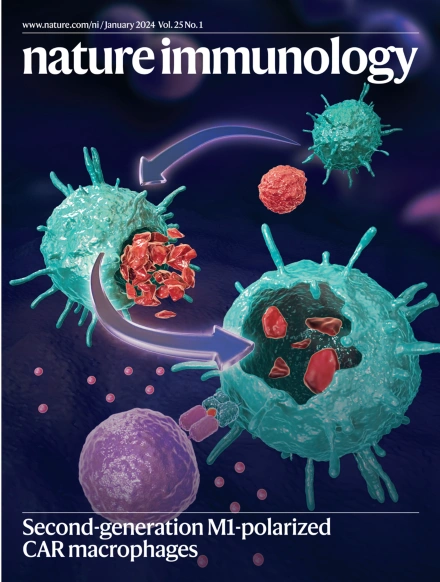The transcription complex p52–ETS1 is essential for germinal center formation
IF 27.6
1区 医学
Q1 IMMUNOLOGY
引用次数: 0
Abstract
The NF-κB family comprises five transcription factors (RELA, RELB, C-REL, NF-κB1 (p50) and NF-κB2 (p52)) that form homo- or heterodimers among themselves to regulate gene expression by binding DNA. Here we show that p52 activates transcription without directly binding DNA but as a heterotetrameric complex with ETS1, a transcription factor outside the NF-κB family. By generating a knock-in mouse model (Nfkb2ki/ki) with three mutated residues on p52 required for its interaction with ETS1, but not RELB, we demonstrate that the p52–ETS1 complex regulates the expression of transcription factors OCT1 and OBF1, which are known to be critical for the germinal center program. Consequently, B cell-intrinsic expression of the p52–ETS1 complex was indispensable for splenic germinal center B cell formation and T cell-dependent antibody responses. Functionally, loss of p52–ETS1 interaction led to diminished antigen-specific IgE, thereby protecting mice from allergic responses. Collectively, our findings expand current knowledge of NF-κB signaling and may provide new therapeutic targets for the treatment of allergic diseases. Tergaonkar and colleagues identify a noncanonical interaction between the NF-κB transcription factor family member p52 and the ETS family member ETS1. They find that the p52–ETS1 complex is required for splenic germinal center B cell formation and T cell-dependent antibody responses.


转录复合体p52-ETS1对生发中心的形成至关重要
NF-κ b家族包括5个转录因子(RELA、RELB、C-REL、NF-κ b1 (p50)和NF-κ b2 (p52)),它们之间形成同源或异源二聚体,通过结合DNA调节基因表达。在这里,我们发现p52激活转录不直接结合DNA,而是作为一个异四聚体复合物与ETS1,一个转录因子外的NF-κB家族。通过构建敲入小鼠模型(Nfkb2ki/ki),发现p52 - ETS1复核调节转录因子OCT1和OBF1的表达,这两个转录因子对生发中心程序至关重要。因此,B细胞内p52-ETS1复合物的表达对于脾生发中心B细胞的形成和T细胞依赖性抗体反应是必不可少的。功能上,p52-ETS1相互作用的缺失导致抗原特异性IgE减少,从而保护小鼠免受过敏反应。总的来说,我们的发现扩展了NF-κB信号传导的现有知识,并可能为过敏性疾病的治疗提供新的治疗靶点。
本文章由计算机程序翻译,如有差异,请以英文原文为准。
求助全文
约1分钟内获得全文
求助全文
来源期刊

Nature Immunology
医学-免疫学
CiteScore
40.00
自引率
2.30%
发文量
248
审稿时长
4-8 weeks
期刊介绍:
Nature Immunology is a monthly journal that publishes the highest quality research in all areas of immunology. The editorial decisions are made by a team of full-time professional editors. The journal prioritizes work that provides translational and/or fundamental insight into the workings of the immune system. It covers a wide range of topics including innate immunity and inflammation, development, immune receptors, signaling and apoptosis, antigen presentation, gene regulation and recombination, cellular and systemic immunity, vaccines, immune tolerance, autoimmunity, tumor immunology, and microbial immunopathology. In addition to publishing significant original research, Nature Immunology also includes comments, News and Views, research highlights, matters arising from readers, and reviews of the literature. The journal serves as a major conduit of top-quality information for the immunology community.
 求助内容:
求助内容: 应助结果提醒方式:
应助结果提醒方式:


